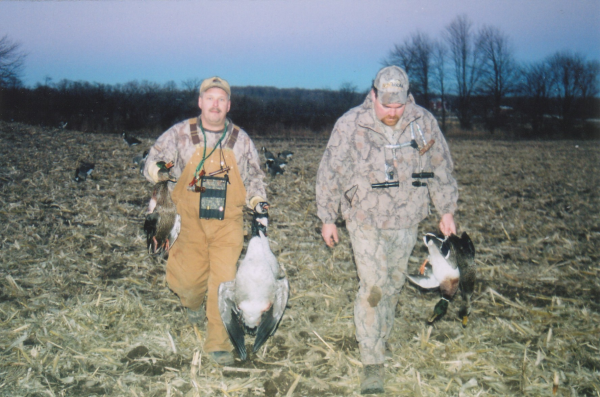Clouds Of Mallards, Hunters Meet On Stubble Corn Field
Joe Porten had forecast the impending, late afternoon storms moving off of Green Bay and destined for the mainland. As the day died though, blue skies, sunshine and gentle breezes challenged the prediction and offered no hint of the dark clouds growing on the horizon. A calm before a perfect storm hung over Door County.
A special rain would fall precisely as predicted, though, on a gradually sloping field where two hunters melded in layout blinds with the stubble corn. Mallards and black ducks too numerous to count and the occasional flock of bantering geese dropped from the skies. With each arrival of ten birds, twenty, one hundred, one or two would tumble as a different kind of thunder rolled over a tiny piece of northeast Wisconsin.
When Porten does the homework and three-time Wisconsin goose calling champion John Volkman of Neenah sets the decoys and extends his welcomes to the arriving flocks with a promise of food and rest, the birds lose. The birds lost Wednesday.
Two weeks before Thanksgiving, avid waterfowler Porten, of Sturgeon Bay “couldn’t have bought you two mallards” in Door County. Indicative of his scouting efforts, Porten puts 10,000 miles each fall on his truck, most of which come striving to locate the ducks and geese he will eventually hunt in the counties of the northeast.

When freezing temperatures are a distant promise and Wisconsin water is wide open, Porten finds the wheat fields of October being used by the ducks and geese and sets his ambushes. And late in the season when ice claims the smaller lakes and potholes and the ducks drop into the stubble to claim the waste corn left in the wake of harvest, Porten remains almost exclusively a field hunter. (Above: A Dynamic waterfowl hunting duo, Joe Porten and John Volkman of Door County call it a day at sunset and retrieve some of the greenheads, drake black ducks and geese misled by their calls and decoys on a cut cornfield near Green Bay.)
“I get wet now only twice a year,” he said. “On the first day of the gun deer season and the day after. As I get older it’s going to be a little harder to trudge around in the marshes with waders on. I’ll be able to hunt in the fields for the rest of my life. I couldn’t care less if I ever shoot another duck. To me scouting is everything. It’s discovering where they’re roosting, what fields they’re using to feed, getting permission to hunt, playing the wind and setting up properly with the decoys and finally having it all come together where they come in and land on your forehead.”
In Wisconsin’s southern zone, a split season enables hunters to pursue ducks into early December. Some hunters prefer to target early season teal or woodducks. Others don’t support the late season, claiming that the birds migrate to warmer climates as the majority of Wisconsin’s lakes and marshes freeze. Volkman vigorously disputes that theory, claiming that the best hunting predominantly comes late. The birds, he said, need very little open water as long as food remains abundant and accessible.
“Significant snow fall is the only thing that can push the ducks south,” Volkman said. “Geese and ducks are constantly evolving to their environment. Times have changed. The birds have adapted to the weather and different agricultural practices. There are thousands of geese here in the winter. Twenty years ago there were none. Ducks are no different. They’re staying north longer.”
According to Volkman, ducks and geese do not require large expanses of open water to remain in Wisconsin; just enough open water to drink, and fields to eat. In addition to metropolitan ponds with heated water, fountains, or flocks of swimming geese keeping water open, some large bodies of water rarely or never freeze into December regardless of plummeting temperatures; including Green Bay, Lake Michigan, Big Green Lake, river systems and the Madison chain.
Scouting fields around those roosting areas, then, is the key. As a hunter who targets waterfowl exclusively and passionately, Porten has embraced the process thoroughly over the years and attributes selecting a field to a kind of sixth sense that is developed with experience. A process premised on when corn was cut and where in relation to roosting birds, and whether standing corn or treelines on a potential ambush area may leave the birds streetwise to the possibility of hidden hunters.
“I don’t second guess the birds,” he said. “I’ve been burned setting up in a cut corn field because I found the ducks in a mud field right next to it with no food at all. Of course they came back to the mud field. The ducks have open water and plenty of food to stay all winter. The farming practices are so much improved over the past 20 years you wouldn’t believe the waste grain laying out here in the fields.”
“The huge flocks didn’t show up until Thanksgiving. With this warm weather, there are huge numbers of mallards still in Canada. The hunters in Arkansas and Louisiana are asking, ‘when are you going to send some birds down here?”
By sunset Wednesday, a half-dozen drake mallards and black ducks and a pair of geese had fallen among the scores of field decoys. Several greenheads were missed. An advantage to the late hunt, Volkman said, is that the bird’s full plumage easily enables the hunter to identify the ducks and pass on hens. Another is the sheer numbers of ducks that makes a flock in the distance appear to be a moving cloud on the winds.
“When is the last time you had one thousand mallards come into your decoys in 20 minutes?” Volkman asked. “The last five years, the largest movement of mallards into Wisconsin was during or after the gun deer season.
This Ellis column originally appeared in December 2004.






